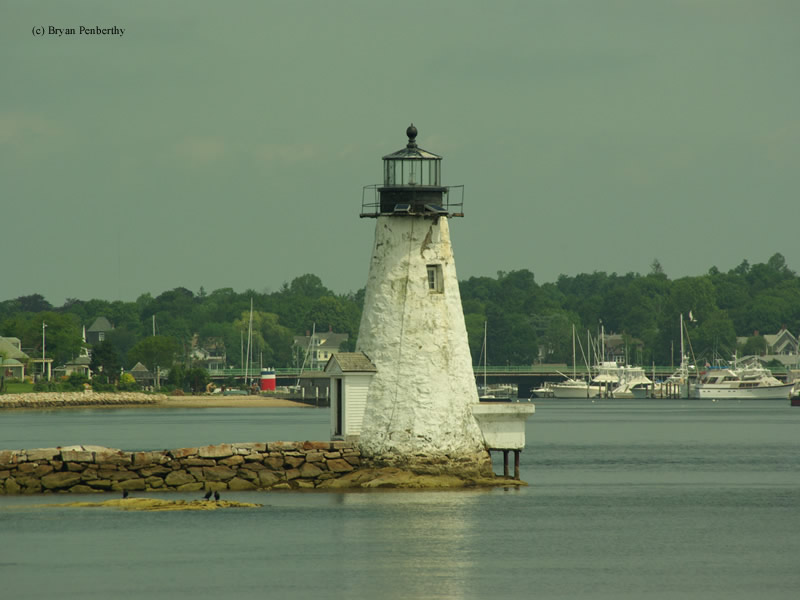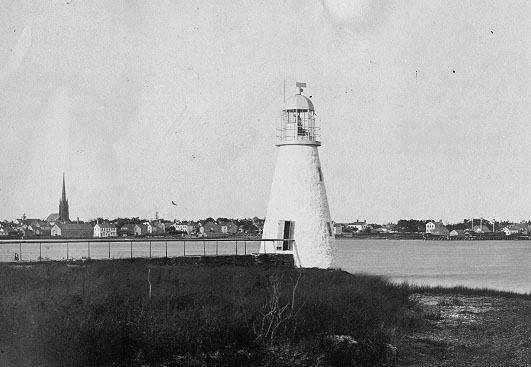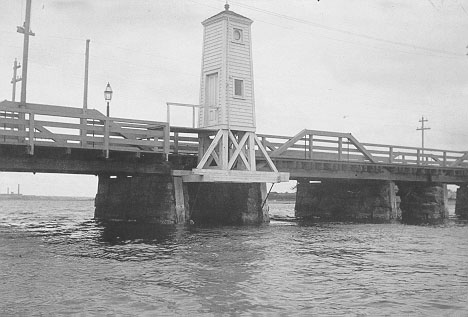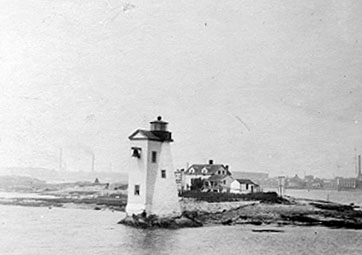Palmer Island Lighthouse
New Bedford, Massachusetts - 1849 (1849**)

History of the Palmer Island Lighthouse
Posted/Updated by Bryan Penberthy on 2013-09-21.
Although the Palmer Island Lighthouse wasn't built until 1849, the port town of New Bedford was first explored as early as 1602 by Bartholomew Gosnold, but wasn't settled by Europeans until some fifty years later. It would take until 1787 before it would be incorporated as the town of New Bedford.
The late 1700s would see a lot of growth and development in the town. The town's first post office and newspaper were started in 1792, and some four years later the first bridge was constructed in town. Although farming was the main way of life in the area, by the late 1700s, residents began engaging in whaling.
One such individual, William Rotch, Jr., is attributed with having brought the whaling industry from Nantucket to the Bedford Village, which is today known as New Bedford. He set up a whale fishery on the ten waterfront acres of land his grandfather had purchased in 1765. He eventually came to run the family business of harvesting the whales, processing the parts into saleable goods, and then bringing the goods to market.
Although the Clark's Point Lighthouse, located at the confluence of the Acushnet River and Buzzards Bay, helped guide vessels into the Acushnet River, it provided little guidance within the New Bedford Harbor.
As early as March 3, 1837, a lighthouse was recommended at the mouth of the New Bedford Harbor, and Congress set aside $2,000 for the project. However, it would come recommended by lighthouse inspector I.W.P. Lewis in his 1843 coastal survey that an additional lighthouse be established on Palmer Island as it "would add materially to the facilities required on entering this important harbor."
By the 1840s, New Bedford was experiencing as much success with whaling, if not more than Nantucket. Whale meat and oil was extremely valuable, and the industry provided many jobs to the locals. Two things would help propel New Bedford past Nantucket as the most powerful whaling town and become one of the richest per capita cities in the world.
A local blacksmith by the name of Lewis Temple set about a way to revolutionize the whaling industry and created the toggling harpoon. Simply known as the toggle iron, the device was a harpoon that would lodge under the blubber of the whale making it virtually impossible for the animal to break free.
The other factor that would drive New Bedford forward was the depth of the port. Nantucket Harbor was relatively shallow with many moving sand bars; this meant that many of the larger sailing vessels could not cross the bar. The New Bedford Harbor didn't have this problem. Many of the newer and larger vessels which sat deeper in the water could still call New Bedford Harbor home.
 Palmer Island Lighthouse with bird-cage lantern (Coast Guard)
Palmer Island Lighthouse with bird-cage lantern (Coast Guard)
An act of Congress on August 14, 1848 set aside an appropriation of $3,500 for the construction of the Palmer Island Lighthouse. A twenty-four-foot white rubble-stone tower was designed and constructed by architect Charles M. Pierce on a one acre plot of land at the northern tip of the island.
The tower had wooden floors, door, and windows and was topped off with an iron "birdcage-style" lantern. Access to the lantern was via a short iron stairway. To connect the lighthouse with the higher part of the island, a walkway was constructed. The first keeper, William Sherman, established the light for the first time on the night of August 30, 1849.
On July 5, 1850, the lighthouse was inspected and the following report was submitted:
This is a new establishment. Tower of the light-house built of stone, and tight; dwelling is of wood and somewhat leaky; lantern is a good one, and the whole taken together is a fair piece of work. Lamps are of brass, with iron inside burners; had not any repairs to make or tinkering to do. Found the apparatus clean; but the dome of the lantern, which was painted white, was just as black as it could be - caused by burning Mr. Rodman's lamp with whale oil. Dwelling is too small and needs a porch.
In 1852, a seawall was constructed on the eastern side of the island six-rods long (roughly one-hundred feet.) Over the course of the 1850s, most American lighthouses had adopted the superior Fresnel lens. Palmer Island Lighthouse received a fifth-order Fresnel lens in 1857 and a new lantern several years later in 1863. Over the two years dated 1867 to 1869, the tower and dwelling underwent comprehensive repairs.
Starting in 1881, some maintenance work took place at the station. Interior work included putting down a new floor and replacing a drain pipe. Other exterior work took place including a new roof for the boathouse and a hand rail leading across the dike to the tower.
For about three years, from 1888 to 1891, the Palmer Island Lighthouse acted as a front range light to the Fairhaven Bridge light. Mariners would line up the Palmer Island Lighthouse with the red light of the Fairhaven Bridge tower to safely guide them past Butler Flats. The light on the bridge was discontinued on March 31, 1891.
 Fairhaven Bridge Lighthouse (Courtesy Coast Guard)
Fairhaven Bridge Lighthouse (Courtesy Coast Guard)
The Annual Report of the Lighthouse Board dated 1888 had the following entry:
128. Fairhaven Bridge, between New Bedford and Fairhaven, Massachusetts - With a special appropriation made by the act approved August 4, 1886, a small beacon house was erected on this bridge between New Bedford and Fairhaven, for a range with Palmer's Island light to guide vessels clear of the point of Butler's Flats.
After the discontinuance of the Fairhaven Bridge Light, a light on the nearby Wamsutta Mill was used as a range light. It is unclear however, how long this light was used.
Palmer Island, encompassing six-acres, was not always as barren as it is today. At one point, shortly after the Civil War had ended, several structures were erected on the island. The island saw a dance hall, hotel, and wharf established with steamer service from New Bedford. It became a place that the whalers would frequent while not out at sea to blow off steam, sometimes a little too much. In 1883, a barbed-wire fence was constructed to separate the lighthouse property from that of the hotel.
The hotel soon gained a shady reputation, and by 1890 would be closed. The southern five acres were acquired shortly after for an amusement park. The awkwardness of landing and leaving the island proved too much, and after several dismal seasons, the park closed.
With the amount of shipping traffic entering and leaving the New Bedford Harbor (more than 1800 vessels in 1890), it would become clear that a new lighthouse would be needed to replace the aging Clark's Point Lighthouse at Fort Tabor and to act as a new range light with Palmer's Island Lighthouse. Recommendations had started appearing in the Annual Report of the Lighthouse Board in 1889. The following entry was placed:
- Butler's Flats, New Bedford Harbor, Buzzard's Bay, Massachusetts - The entrance, near buoy No. 9, on the point of Butler's Flats, to the lower harbor of New Bedford, is narrow, obscure, and difficult to find in snow-storms, fogs, and dark nights. If a light, with a fog-signal, were placed on that point it would accurately mark the entrance as well as the point where vessels alter their course; would guide them to an anchorage in the lower harbor, and would form, with Palmer's Island light, a range very useful in enabling them to avoid North Ledge, Henrietta, and Hurricane Rocks in Buzzard's Bay, and greatly benefit navigation. The site is submerged to the depth of about 12 feet at mean low water. The estimated cost of a suitable structure is $45,000.
It would take another nine years before the Butler Flats Lighthouse was completed to guide mariners past the dangerous shoal. To help differentiate it against the Butler Flats Lighthouse, the color of the light of the Palmer Island Lighthouse was changed on June 28, 1899.
The station was upgraded on May 31, 1900 when a new fog bell was installed in a pyramidal wooden tower. The bell, automated by machinery, was replaced at some point and installed on a bell tower attached to the lighthouse. That same year new stairs and a half deck of wood were built in the tower.
 Palmer Island Lighthouse with bell tower (CG)
Palmer Island Lighthouse with bell tower (CG)
Improvements at the station would continue for several years. Various general repairs were made in 1901, but the big change came in the form of 75-tons of riprap stones placed on the beach to afford protection from storms. Changes in 1902 would include a covered walkway being constructed over the exposed part of the path to the tower and boat slip and a fence around the station being repaired. An oil house was constructed in 1905.
Keeper Arthur Small and his wife Mabel came to the Palmer Island Lighthouse from the Boston Harbor's Narrows Lighthouse, commonly called the "Bug Light" in 1922. Keeper Small was a gifted artist and was known to paint frequently while on the island.
Historian Edward Rowe Snow quoted Keeper Small on how the average person thinks that the job of a lighthouse keeper was very peaceful and serene. When asked about the importance of his work with respect to the commerce of New Bedford Harbor, Keeper Small replied:
It is a popular idea that there is very little to do except for striking a match once a day to light the lamp. Few of these landlubbers realize that if a fog comes in during the middle of the night the keeper must be ready to turn on the fog signal at once, for if the fog bell is silent for a moment, even then a great vessel may be feeling her way up into the harbor, depending on the ringing of the fog signal bell for her safety.
The channel in New Bedford Harbor is so narrow, that if a large vessel went down, all shipping in or out of the harbor would be at a standstill. The coal for the electric light company would not reach the pier, and the cotton steamers likewise would find it impossible to dock. In a short time all the city would be seriously crippled. That is what makes me angry when I hear of the easy job of a lighthouse keeper, as described by some fair weather sailor or inland resident.
The day of September 20, 1938 seemed like any other day for Keeper Small's wife Mabel. She was dropped off in nearby Fairhaven for her sewing circle meeting. One of her friends noticed her looking anxiously out the window at the ocean. When asked why, she replied that she was worried that Keeper Small wouldn't be able to row over to Fairhaven to pick her up due to the swelling sea.
Her friend dropped her off at the rendezvous point where Keeper Small was waiting to pick her up. While leaving the dock, she shouted "See you girls next week!" The next day, one of the worst hurricanes to ever strike New England would make landfall and she would not survive.
The Great Hurricane of 1938 would start as a category 5 storm in the open Atlantic. But by the time it made landfall along the southern New England coast, it would be downgraded to a category 3 hurricane with wind gusts reaching 121-mph. Like many other lighthouses along the Atlantic coast such as the Beavertail and Whale Rock Lighthouses, Palmer Island Lighthouse took a direct hit.
As the storm approached, Keeper Small instructed his wife to stay in the oil house, which was on the highest point of the island. As he was walking the 350 feet from the house to the lighthouse, he was struck by a large wave and washed into the sea. Mabel Small saw this, and attempted to launch the station's boat to rescue him. However, in the process a giant wave smashed the boathouse.
Keeper Small witnessed the giant wave smashing the boathouse and lost sight of his wife. At some point, he was knocked unconscious by debris and later came to in the middle of some wreckage. Although injured, he was able to keep the light shining through the storm.
Mabel Small's body was later discovered and identified in Fairhaven. After an extended leave, Arthur Small would go on to become the keeper of the Hospital Point Lighthouse in Beverly, Massachusetts.
Franklin Ponte, the assistant keeper of the Boston Harbor Lighthouse, was sent to Palmer Island Lighthouse to take over as a temporary keeper. The only two structures to survive the hurricane were the oil house and the lighthouse.
Keeper Ponte would live have to live for nearly one month in the lighthouse before the Coast Guard sent new living quarters to the island. Martin Maloney would take over keeper duties at some point and serve until 1941 when the lighthouse was automated.
Several other hurricanes would hit the area. The Great Atlantic Hurricane struck the area in 1944, Hurricane Donna struck ten years later, and Hurricane Edna ten days after that. By 1957, the Corps of Engineers recommended construction of a hurricane dike to protect the New Bedford Harbor. President Eisenhower signed a public works bill into law in 1958; however problems plagued the project that would cause a delay of nearly four years.
Construction of the hurricane dike to protect the New Bedford Harbor started in November of 1962 and took nearly four years and $19,000,000 to complete. The wall consists of 899,000 tons of granite rock, some the size of automobiles, spans 3.5 miles and is higher and wider than the Great Wall of China.
With the construction of the seawall, the lighthouse was no longer needed. Decommissioning took place in 1962. With the seawall in place, access to the island was easier as one could walk the wall to the island. This made vandalism of the vacant tower more rampant. One such arson incident in 1966 left the interior of the tower gutted due and nearly destroyed the lantern.
Over the years, ownership of the island passed through many hands. But by 1978, the City of New Bedford had become the owner. A local resident, Dr. John B. O'Toole III, pushed for preservation. The local community pitched in to help with the efforts.
Local kids picked up trash on the island, a new 500-pound steel door was installed to deter future vandalism, and a new iron spiral staircase was donated by the New Bedford Fire Department.
Another restoration would take place in 1989, but vandals would strike again. Throughout most of the 1990s, the lighthouse remained dark. The City of New Bedford, as one of its Millennium projects, decided that the lighthouse should be restored and relighted.
The badly damaged lantern was removed from the tower and taken to the city's wastewater division. There, a welder named Jose Pereira rebuilt it. The rebuilt lantern was reinstalled on August 25, 1999.
Painting Labor was provided by the Bristol County Sheriff's Department pre-release program. A new solar-powered light was installed in the lantern utilizing a 250-mm optic which was paid for with donated funds.
On August 30, 1999, exactly 150 years after the original lighting, a large crowd gathered to witness the relighting of the Palmer Island Lighthouse. The Mayor of New Bedford, Frederick M. Kalisz Jr. supplied lighted oil lanterns to crews aboard three whaleboats, which then proceeded over to the island. When the mayor waved his lantern in the air, the lighthouse was switched on.
Directions: The lighthouse sits on Palmer Island just behind the City of New Bedford's hurricane wall. From Rodney French Blvd, head east on Cove Street, then north on Harbor Street. Then head east on Gifford Street. Access to the hurricane wall will be available at the end of Gifford Street.
Access: The grounds are open, the tower is closed.
View more Palmer Island Lighthouse picturesTower Height: 24.00'
Focal Plane: 34'
Active Aid to Navigation: Deactivated (1962)
*Latitude: 41.62700 N
*Longitude: -70.90900 W
See this lighthouse on Google Maps.
